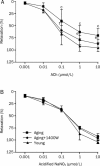Inhibition of iNOS protects endothelial-dependent vasodilation in aged rats
- PMID: 20835265
- PMCID: PMC4012905
- DOI: 10.1038/aps.2010.111
Inhibition of iNOS protects endothelial-dependent vasodilation in aged rats
Abstract
Aim: To examine whether iNOS contributes to endothelial dysfunction in aged rats.
Methods: Male Sprague Dawley rats were divided into three groups: young rats, aged rats treated with vehicle and aged rats treated with N-[3-(Aminomethyl) benzyl] acetamidine (1400W, 1 mg/kg, ip). Vasorelaxation was measured in isolated thoracic aorta. iNOS expression of thoracic aortic arteries was detected using immunohistochemistry and Western blot. Nitrotyrosine (a marker for peroxynitrite formation) content and expression in thoracic aortic tissue were determined using enzyme linked immunosorbent assay and immunohistochemistry.
Results: Maximal relaxation induced by acetylcholine (10⁻⁹ to 10⁻⁵ mol/L) in the aged rats treated with vehicle was significantly decreased (70%±15%, P<0.01), as compared with the young rats (95%±8%). However, the maximal relaxation induced by acidified NaNO2 (an endothelium-independent vasodilator) had no significant difference between the two groups. Moreover, iNOS and nitrotyrosine expression increased in the vessels of the aged rats. In the aged rats treated with 1400W (a highly selective iNOS inhibitor) nitrotyrosine expression was reduced and acetylcholine-induced vasorelaxation was markedly improved (maximal relaxation was increased to 87%±8%, P<0.05), but the acidified NaNO₂-induced vasorelaxation had no significant change.
Conclusion: Our study demonstrated that inhibition of iNOS by 1400W increased endothelium-dependent vasodilation in aged rats. The mechanism was related with attenuation of peroxynitrite formation.
Figures



Similar articles
-
Lipopolysaccharide-induced impairment of nitric oxide-mediated vasorelaxation and protective effects of nitric oxide synthesis inhibitors in isolated rat mesenteric arteries.Arzneimittelforschung. 2010;60(6):315-9. doi: 10.1055/s-0031-1296293. Arzneimittelforschung. 2010. PMID: 20648920
-
Dose-dependent effects of a selective phosphodiesterase-5-inhibitor on endothelial dysfunction induced by peroxynitrite in rat aorta.Eur J Pharmacol. 2009 Aug 1;615(1-3):155-62. doi: 10.1016/j.ejphar.2009.05.020. Epub 2009 May 29. Eur J Pharmacol. 2009. PMID: 19482016
-
Antiperoxynitrite Treatment Ameliorates Vasorelaxation of Resistance Arteries in Aging Rats: Involvement With Protection of Circulating Endothelial Progenitor Cells.J Cardiovasc Pharmacol. 2016 Nov;68(5):334-341. doi: 10.1097/FJC.0000000000000420. J Cardiovasc Pharmacol. 2016. PMID: 27824721
-
Effect of 1400W on blocking lipopolysaccharide-induced microglial toxicity to preoligodendrocytes.World J Pediatr. 2010 Aug;6(3):249-54. doi: 10.1007/s12519-010-0203-2. Epub 2010 Jun 12. World J Pediatr. 2010. PMID: 20549418
-
Adiponectin improves endothelial function in hyperlipidemic rats by reducing oxidative/nitrative stress and differential regulation of eNOS/iNOS activity.Am J Physiol Endocrinol Metab. 2007 Dec;293(6):E1703-8. doi: 10.1152/ajpendo.00462.2007. Epub 2007 Sep 25. Am J Physiol Endocrinol Metab. 2007. PMID: 17895290
Cited by
-
Mineralocorticoid Receptor in Myeloid Cells Mediates Angiotensin II-Induced Vascular Dysfunction in Female Mice.Front Physiol. 2021 Mar 29;12:588358. doi: 10.3389/fphys.2021.588358. eCollection 2021. Front Physiol. 2021. PMID: 33854438 Free PMC article.
-
Chronic Piromelatine Treatment Alleviates Anxiety, Depressive Responses and Abnormal Hypothalamic-Pituitary-Adrenal Axis Activity in Prenatally Stressed Male and Female Rats.Cell Mol Neurobiol. 2022 Oct;42(7):2257-2272. doi: 10.1007/s10571-021-01100-8. Epub 2021 May 18. Cell Mol Neurobiol. 2022. PMID: 34003403 Free PMC article.
-
Selective anticancer agents suppress aging in Drosophila.Oncotarget. 2013 Sep;4(9):1507-26. doi: 10.18632/oncotarget.1272. Oncotarget. 2013. PMID: 24096697 Free PMC article.
-
The Effect of an Elevated Dietary Copper Level on the Vascular Contractility and Oxidative Stress in Middle-Aged Rats.Nutrients. 2024 Apr 15;16(8):1172. doi: 10.3390/nu16081172. Nutrients. 2024. PMID: 38674863 Free PMC article.
-
Modulation of vasodilator response via the nitric oxide pathway after acute methyl mercury chloride exposure in rats.Biomed Res Int. 2013;2013:530603. doi: 10.1155/2013/530603. Epub 2013 Aug 19. Biomed Res Int. 2013. PMID: 24024199 Free PMC article.
References
-
- Lakatta EG, Levy D. Arterial and cardiac aging: major shareholders in cardiovascular disease enterprises: Part I: aging arteries: a “set up” for vascular disease. Circulation. 2003;107:139–46. - PubMed
-
- Lakatta EG, Levy D. Arterial and cardiac aging: major shareholders in cardiovascular disease enterprises: Part II: the aging heart in health: links to heart disease. Circulation. 2003;107:346–54. - PubMed
-
- Lakatta EG. Arterial and cardiac aging: major shareholders in cardiovascular disease enterprises: Part III: cellular and molecular clues to heart and arterial aging. Circulation. 2003;107:490–7. - PubMed
-
- Sayer AA, Cooper C. The ageing process. Menopause Int. 2000;6:55–65.
Publication types
MeSH terms
Substances
LinkOut - more resources
Full Text Sources
Medical

